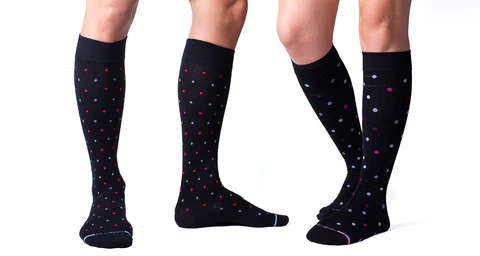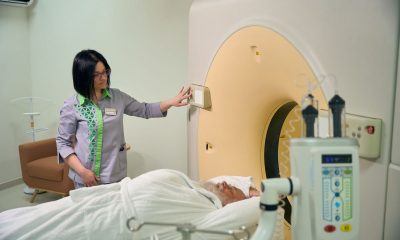Sciatica
Can Compression Socks Help With Sciatica

When treating sciatica, many people are interested in trying any possible solution. Compression socks are effective at improving blood circulation, which may help reduce the symptoms of sciatica. If you are suffering from this condition and are considering trying compression socks, read on to learn more about how they can help.
Do Compression Socks Help Sciatica Pain?
Although compression socks aren’t a cure-all for sciatica, they can help relieve symptoms by increasing blood circulation in the legs. They also help to reduce swelling and pain. They can be helpful for people with sciatica, especially those who walk a lot or spend a lot of time sitting. They are effective for all age groups, from children to the elderly.
The pain caused by sciatica is the result of the sciatic nerve being pinched. This can occur due to a herniated disk in the spine, an overgrowth of bone on the vertebrae, or even a disease such as diabetes. Compression socks can reduce inflammation and swelling in the lower limbs and reduce edema. They can be worn during the day, as well as during sleep. It is important, however, to ensure that compression socks are used correctly.
Compression bandages are another method for reducing pain and swelling. However, it is important to ensure that the bandages don’t completely cut off circulation. In addition to compression stockings, lower back belts can also be beneficial. These devices apply dual compression to the aggravated spinal region, which may help relieve pain and swelling.
What Should You Not Do With Sciatica?
Sciatica is a painful condition caused by inflammation or pressure on the sciatic nerve. Patients should rest and use ice or heat to reduce the pain. Some people also use injections to ease inflammation and stabbing pain. Physical therapy is also a great option. You should also avoid sitting or lying down in bed for long periods. Sitting can worsen the pain.
Regular exercise is essential to maintain core strength and prevent back pain caused by weak or imbalanced muscles. It also prevents the risk of developing low back pain if you are inactive. Inactive patients have a harder time-fighting sciatica because they don’t give their bodies a chance to grow and strengthen. Additionally, resting for extended periods can weaken the body and increase the risk of sciatica.
Physical therapy for sciatica is a crucial part of the recovery process. It will help your body heal and strengthen the muscles in your back, but it will also help improve your nervous system and decrease sciatica symptoms. Physical therapy for sciatica should focus on increasing flexibility and strength and improving alignment and movement patterns. Be sure to stretch and exercise only when it feels comfortable and stop if you feel pain.
What Can Compress Sciatic Nerve?
Sciatica is caused by pressure on the sciatic nerve, which runs from the lower back into the legs. It can cause pain, numbness, and burning that can be intense, and it can feel like you are being shocked or stabbed. There is no single cure for sciatica, and the best way to manage the condition is to rest and wait for relief. In most cases, relief will come within a few weeks.
Sciatica symptoms include numbness and pain in the back of the leg, which radiates into the leg and foot. Patients may also experience painful paresthesias or dysesthesias. They may experience subtle foot weakness or severe motor dysfunction that interferes with gait and hamstring movement.
To treat sciatica, listening to your body’s signals is important. If you experience pain, avoid sitting for long periods and stretch your lower back. This will help loosen the piriformis and gluteal muscles, which can press on the sciatic nerve.
How Do You Wear Socks For Sciatica?
If you suffer from sciatica, compression socks can help you get back on your feet and feel better. Compression socks work by temporarily contracting dilated veins and increasing blood flow to the affected area. This can help relieve pain associated with sciatica, shin splints, and peripheral neuropathy. Compression socks also provide support to the lower leg area, which can reduce inflammation and pain. They are usually made of stretchy material.
A pinched sciatic nerve usually causes pain associated with sciatica. This may occur because of a herniated disc, a tumor, or an overgrowth of bone on the vertebrae. The condition can also be caused by disease, including diabetes. While compression socks are an effective treatment for sciatica, improperly wearing them can lead to significant problems. Besides being uncomfortable, improperly worn compression socks can damage the skin and cause it to break. This is especially true for patients with thin, brittle skin.
If you’re a first-time wearer of compression socks, you should purchase a low-level pair. Low-level compression socks are good for healthy legs and are appropriate for people with mild to moderate symptoms. Higher-level compression socks are better for more severe conditions and should be worn by those who need them.
Are Compression Socks Good For Nerve Pain?
Compression socks can help ease some of the symptoms of peripheral neuropathy. The main benefit of these garments is improved blood flow, which can ease the pain caused by neuropathy. However, compression therapy is not appropriate for everyone. People with peripheral neuropathy should consult a doctor before wearing compression garments.
To get the most benefit from compression socks, choose the right size. They should fit snugly across the calves but not so tight that they interfere with blood circulation. They should also be warm and comfortable so that they do not cause discomfort. It is also best to choose compression socks with graduated levels of pressure. These socks come in various pressure levels, expressed in mmHg. Lower-pressure socks may provide some compression but may not be as effective.
Compression socks are often prescribed for people with neuropathy, a condition caused by diabetes. This condition can cause nerve damage throughout the body, resulting in numbness, tingling, and pins and needles. People with diabetes risk developing complications from peripheral neuropathy, so it is crucial to consult a doctor before using compression socks. Compression socks help to improve circulation by temporarily contracting dilated veins. As a result, increased blood flow to the affected areas can help alleviate pain and burning sensations.
How Many Hours Should Wear Compression Socks?
You may need compression therapy for several reasons, including pain relief and prevention of future medical conditions. These treatments can help prevent blood clots and other problems by improving blood flow. Compression therapy helps the body work against gravity, which can help relieve symptoms and reduce leg swelling.
Compression socks are a great way to reduce leg pain and increase blood circulation. This will help reduce swelling, pain, and other symptoms of sciatica. They can also relieve the pain associated with shin splints and other muscle and vein problems. They are also comfortable and can help you perform daily tasks without pain.
Compression stockings come in various styles and fabrics to suit any occasion. They can also help you keep your legs warm, which can relieve some of your sciatica symptoms. Compression socks mimic your muscles’ motion, allowing the blood to flow from your heart to your legs and other organs. They also prevent blood from pooling and reduce the symptoms of various vein disorders.
When Should You Not Wear Compression Socks?
There are several important factors to consider when choosing compression socks. It would be best to ensure that the socks you choose fit your foot and ankle correctly. They must be snug but not tight, as the wrong size can constrict the blood vessels or even rupture them. Wearing compression socks for long periods can also lead to skin irritation and blood clots.
Compression socks are often used to treat neuropathy and can provide pain relief and ease discomfort. They are also beneficial for people with peripheral neuropathy and can increase blood flow to the affected area. However, people with peripheral neuropathy should always consult their physician before wearing these garments.
Compression socks work by applying pressure to the leg and foot. The pressure is graduated, with the strongest compression at the ankle and less compression toward the top. This helps prevent blood from pooling in the leg and forces it to flow back toward the heart. In addition, the reduced pressure on blood vessels reduces swelling. However, if you wear compression socks and find them uncomfortable, it may be a sign that you are wearing the wrong size.
Compression socks may reduce pain and inflammation in the legs. They may also improve circulation, which can help prevent leg cramps. For those with sciatica, compression socks can be an effective treatment. They help reduce swelling, promote circulation and relieve pain.
Conclusion
While there is no instant cure outside of surgery, compression socks may relieve sciatica nerve pain. For instance, it’s common for physicians to suggest wearing compression socks for shin splints as they make everyday movements easy. Shorts for men and women are ideal for herniated discs and sciatic nerve pain. A chiropractor can help relieve sciatica pain. Socks with 20-30 mmHg of pressure are typically recommended for those with moderate edema, lymphedema, varicose veins, venous reflux, or more severe swelling. Multimodal therapy (including medicines, physical therapy, psychological counseling, and sometimes surgery) is usually required to treat neuropathic pain.

Doctor Osvaldo Pepa, Neurosurgery Service Physician at Hospital San Martin, La Plata, Argentina. I graduated last November 16, 1984 with a Medical Degree at the Universidad Nacional de La Plata. The Medical Board of La Plata, District 1, licensed me as a Neurosurgeon in 1990. I hold a Provincial and National License and an active member of the Neurosurgery Society of La Plata, World Ozone Therapy Federation, and Inter American Society of Minimally Invasive Surgery.

























